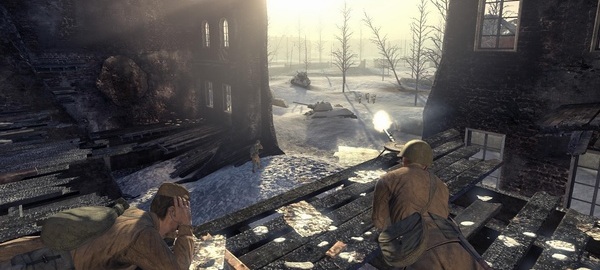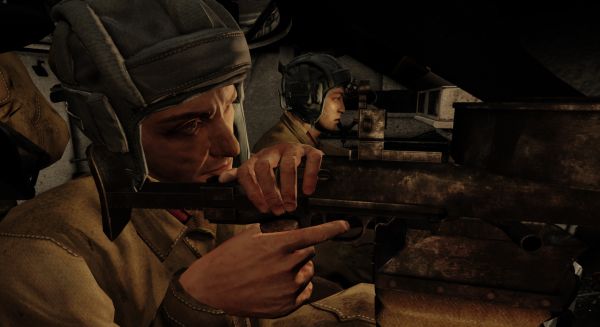Back in 2006, Tripwire Interactive released an incredibly realistic and tactical multiplayer FPS by the name of Red Orchestra, set in World War II. It was clear from its release that Tripwire had struck a nerve. Some lauded it for the intense realism and satisfying gameplay that came with it while others put it on a pedestal as an example of how realism can't be fun. No matter the division, Red Orchestra received several awards, and a steady community which is still playing it to this day. Now, Tripwire has released the sequel, Red Orchestra 2: Heroes of Stalingrad, with heavy expectations set on it to live up to its predecessor. Does it? The short answer is that it actually exceeds those expectations. For the long answer, the why, you'll have to read on.
There is a single-player component to Red Orchestra 2, though it is relatively useless. It takes place on maps from the multiplayer mode and is essentially multiplayer matches with bots. There are a few differences, such as snappier respawning and cutscenes in between missions. These changes don't make up for what ultimately cripples the single-player, however, which is the bot AI. Red Orchestra 2 is a difficult game in multiplayer, one where being in the open for a second too long can result in the player losing his head. In single-player, though, you can run across an open plain for 15 seconds without getting shot when there are clearly multiple enemies aiming at you with rifles. This incompetent bot AI really kills the experience, making it boring for veterans, and non-educational for newcomers. If you want to learn how to play the game, take the trial by fire and play online from day one.
The combat model is incredibly rewarding. Every weapon is an authentic WWII weapon used on the Eastern Front, and they all behave like their real-life counterparts. All of the shots feel natural, landing where one would expect them to, with bullet drop, leading targets, and manual bolting/reloading, should you desire it. The weapons all feel capable of hitting where you aim, but there's still room for finesse in the targeting for Red Orchestra veterans. Bullets, realistically, can also penetrate through walls. Since the most class slots available are usually Riflemen, most combat takes place at range. These factors, combined with the probable one-hit kills, make death a common occurrence in Red Orchestra 2. 
The common deaths and realistic weapons can make the first few hours a daunting experience, but once you understand it, and have a handle on the tactics, the gameplay is quite satisfying. The combat is all about positioning, getting a drop on your opponent with a superior vantage point, or, if you both see each other at once, who has the quicker trigger finger and greater accuracy. The large amount of deaths, and relative rarity of kills compared to Call of Duty/Battlefield, make those times you do drop an enemy that much more satisfying.
The moment-to-moment combat isn't the only thing that is good though. The way you have to coordinate with your teammates to do well is great, too. You need three players to effectively pilot a tank, though this is somewhat undermined by the insanely accurate AI machine gunners when there are no other players in the tank. Each of the classes play off of and need each other, and teams are divided into commandable squads. Those that do get a commander position, either from random selection or being at the top of the scoreboard, can order teammates using a radial menu, call in artillery, and force respawn their squad. This system works very well, for the most part, except for the spawning. Similarly to Bad Company 2, Red Orchestra 2 lets you spawn on your squad leader. However, it doesn't let you spawn on any normal squad mates, and it doesn't offer any incentivizing benefit for being in a squad, other than the few XP boosts for defending a squad leader once in a blue moon.
There are several features new to Red Orchestra 2 from its predecessor, designed to make it more accessible to newer players, while keeping the strategies in combat deep enough for veterans of the original. These include a rather long and fast sprint, a cover system similar to that of Killzone 2's, customizable realism settings for server hosts, and weapon/level progression system, which unlocks new attachments and weapons for specific classes. Most of these inclusions improve Red Orchestra 2 over the original, though the weapon/level progression system feels somewhat pointless, given the large number of classes and the power of the starting weapons. It doesn't help that the stats system is somewhat broken as of this review.

This brings up my biggest complaint with Red Orchestra 2. While the core gameplay and strategies are incredibly rewarding and engaging, there is an undeniable lack of polish and several severe bugs. As of this review, the server list only works half the time, the stats tracking is inconsistent at best, players can easily get stuck in the geometry, and more. This isn't even getting into the graphical bugs and glitches. It's a shame that a game with such a great combat model and authenticity is weighed down by the technical shortcomings, but Tripwire has been patching it regularly, so these will hopefully be fixed in the future. At the moment, though, it's a serious point of criticism.
The visuals and audio combine to form an immersive experience in Red Orchestra 2. One can hear soldiers taunting each other, wounded comrades crying out in pain, firefights in the distance, and authentic gunshot sounds. The soldiers from both the Axis and Allies have animations particular to their real-life training and tactics, with Germans running with one hand grasping their weapon while sprinting, and Russians holding their weapon with both hands in the same situation. The environments themselves are painstakingly modeled after real WWII landmark battles and locations, such as Pavlov's House and a building which 12 Russians held for 2 months against the Nazi forces. Tanks for both sides are modeled realistically. There is music, which, most of the time, isn't intrusive and simply adds to the atmosphere. There are some breaks in the immersion, however, such as when previously stated bugs come into effect, and your Mosin Nagant rifle starts tilting infinitely upward, or a fellow soldier shoots with his heads stuck inside a train. Besides these bugs, however, Red Orchestra 2 admirably portrays what World War II was like on the Eastern Front.
Red Orchestra 2 is probably the best multiplayer shooter I've played this year. The authentic World War II atmosphere, environments, and weapons combine with the incredibly satisfying combat to create a unique experience, something increasingly rare in today's FPS market. However, I can't recommend it to everyone, not until the patches iron out most of the game-breaking server bugs. If polish is something that is very important to you, then I suggest you wait a few months before buying Red Orchestra 2. To everyone else who enjoys first-person shooters, buy this game. The realism, strategy, and combat make up for all of the balance and polish issues.